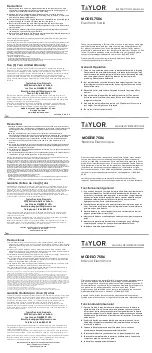
© Adam Equipment Company 2021
27
Any of these can be printed on any of the 15 lines available. Not all items need to be used
and any one can be used more than once (see section 13.4).
The data for each form will be preceded by a start-of-header <SOH> ASCII character (01)
and terminated with an end-of-transmission <EOT> ASCII character (04). These characters
will be ignored by a serial printer but will allow a computer program which reads the data to
distinguish between this block report format and the single-line output format described
above.
11.3
INPUT COMMANDS USING REMOTE KEYS
The balance can be controlled with the following commands sent using remote keys such
as from a PC. The commands must be sent in upper case letters, i.e. “KT” not “kt”. Press
the Enter key of the PC after each command (the action of Carriage Return is denoted as
<CR> as shown below).
Basic Input Commands:
!KT<CR>
Tares the balance to display the net weight. This is the same as pressing the
[
0/T
] key when the balance is in the normal weighing mode.
!KS<CR>
Enters the setup section. This is the same as pressing the [Setup] key when the
balance is in the normal weighing mode.
Once entered the setup section, the balance can be controlled remotely using the
Input Commands (as mentioned in this table) which will perform the same key
functions as described in section.
!KP<CR>
Transmits data over RS-232 interface. This is the same as pressing the [Print] key
when the balance is in the normal weighing mode.
!KM<CR>
Enters the Modes section. This is the same as pressing the [Mode] key when the
balance is in the normal weighing mode.
!KC<CR>
Enters the Calibration section. This is the same as pressing the [Cal] key when
the balance is in the normal weighing mode.
!KU<CR>
Enters the Unit selection section. This is the same as pressing the [Unit] key
when the balance is in the normal weighing mode.
11.3.1
Invalid input command:
If an invalid command is received, then the command is returned as follows-
Invalid Command
Message returned
Remarks
!NT<CR>
!EU<CR>
Command character is not ‘K’
!KK<CR>
!EK<CR>
Key character is not ‘T’, ‘S’, ‘P’, ‘M’, ‘C’ or ‘U’
!KT-<CR>
!EF<CR>
Command format error, <CR> is not the fourth
character
KT<CR> or !KT -
No reply
Either ‘!’ or <CR> is missing in the command
string
















































